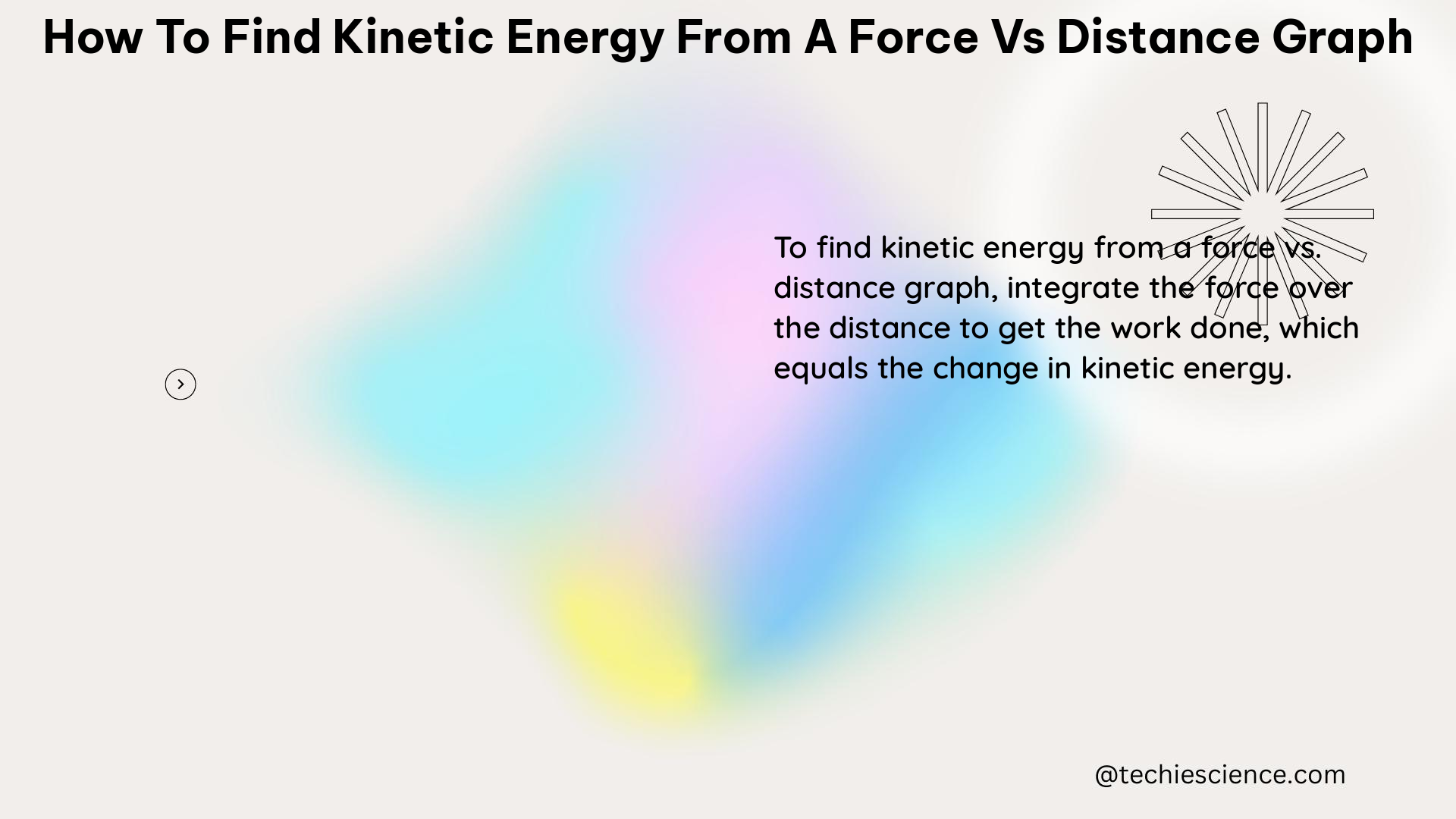Summary
To find the kinetic energy of an object from a force vs. distance graph, you need to calculate the area under the curve, which represents the work done on the object. The work done is equal to the force applied times the distance traveled, which is equal to the area under the curve of the graph. Once you have the work done, you can use the formula for kinetic energy, KE=1/2mv^2, to find the velocity of the object.
Understanding the Relationship between Work, Force, and Distance

The fundamental relationship between work, force, and distance is given by the equation:
Work = Force × Distance
This means that the work done on an object is equal to the force applied multiplied by the distance the object travels. In the context of a force vs. distance graph, the area under the curve represents the work done on the object.
Calculating the Area under the Curve
To calculate the area under the curve of a force vs. distance graph, you can use the following methods:
-
Rectangular Approximation: Divide the distance into small intervals and calculate the area of each rectangle using the force and distance values for that interval. The sum of all the rectangle areas will give you the total work done.
-
Trapezoidal Rule: Divide the distance into small intervals and calculate the area of each trapezoid using the force values at the beginning and end of the interval, as well as the distance. The sum of all the trapezoid areas will give you the total work done.
-
Integration: If the force vs. distance relationship is known, you can integrate the force function over the distance to calculate the area under the curve, which represents the work done.
The choice of method depends on the complexity of the force vs. distance graph and the desired level of accuracy.
Determining the Sign of the Work Done
The sign of the work done is determined by the direction of the force relative to the direction of motion:
- If the force and motion are in the same direction, the work done is positive.
- If the force and motion are in opposite directions, the work done is negative.
In the case of negative work done, the area under the curve will be negative, but you can still use the absolute value of the area to calculate the kinetic energy.
Calculating Kinetic Energy
Once you have the work done on the object, you can use the formula for kinetic energy to find the velocity of the object:
KE = 1/2 × m × v^2
Where:
– KE is the kinetic energy of the object
– m is the mass of the object
– v is the velocity of the object
Rearranging the equation, you can solve for the velocity:
v = √(2 × KE / m)
Example Problem
Suppose you have a force vs. distance graph with the following data:
| Distance (m) | Force (N) |
|---|---|
| 0 | 0 |
| 1 | 10 |
| 2 | 15 |
| 3 | 12 |
| 4 | 8 |
| 5 | 5 |
To find the kinetic energy of the object:
- Calculate the area under the curve using the trapezoidal rule:
- Area of trapezoid 1 (0-1 m): 1/2 × (0 + 10) × 1 = 5 J
- Area of trapezoid 2 (1-2 m): 1/2 × (10 + 15) × 1 = 12.5 J
- Area of trapezoid 3 (2-3 m): 1/2 × (15 + 12) × 1 = 13.5 J
- Area of trapezoid 4 (3-4 m): 1/2 × (12 + 8) × 1 = 10 J
- Area of trapezoid 5 (4-5 m): 1/2 × (8 + 5) × 1 = 6.5 J
-
Total area under the curve = 5 + 12.5 + 13.5 + 10 + 6.5 = 47.5 J
-
Assume the mass of the object is 2 kg.
- Use the formula for kinetic energy: KE = 1/2 × m × v^2
- Solve for the velocity: v = √(2 × KE / m) = √(2 × 47.5 / 2) = 7.75 m/s
Therefore, the kinetic energy of the object is 47.5 J, and its velocity is 7.75 m/s.
Additional Considerations
- If the force vs. distance graph includes both positive and negative force regions, you need to calculate the area under the curve for each region separately and then add or subtract the work done, depending on the direction of the force.
- In some cases, the force vs. distance graph may not be linear, and you may need to use more advanced integration techniques to calculate the area under the curve.
- The mass of the object is a crucial parameter in the kinetic energy calculation, so it’s important to have an accurate value for the mass.
- If the object is moving at relativistic speeds, you may need to use the relativistic kinetic energy formula instead of the classical formula.
Conclusion
By understanding the relationship between work, force, and distance, and applying the appropriate techniques to calculate the area under the force vs. distance graph, you can determine the kinetic energy of an object. This knowledge is essential for analyzing the motion and energy of various physical systems in physics.
References
- Calculating Kinetic Energy from Force-Distance Graph: https://www.physicsforums.com/threads/calculating-kinetic-energy-from-force-distance-graph.190448/
- Kinetic Energy – Physics Tutorials: https://www.physicstutorials.org/energy-work-power/kinetic-energy/
- Relativistic Energy | Physics – Lumen Learning: https://courses.lumenlearning.com/suny-physics/chapter/28-6-relativistic-energy/

The lambdageeks.com Core SME Team is a group of experienced subject matter experts from diverse scientific and technical fields including Physics, Chemistry, Technology,Electronics & Electrical Engineering, Automotive, Mechanical Engineering. Our team collaborates to create high-quality, well-researched articles on a wide range of science and technology topics for the lambdageeks.com website.
All Our Senior SME are having more than 7 Years of experience in the respective fields . They are either Working Industry Professionals or assocaited With different Universities. Refer Our Authors Page to get to know About our Core SMEs.